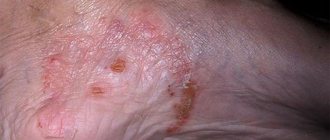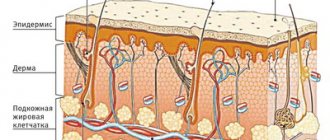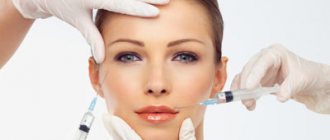Cost: from 1500 rub.
Sign up
Pregnancy is a wonderful time for any woman, especially when it is a planned and desired event in the life of a married couple. Unfortunately, due to various circumstances, pregnancy does not always occur naturally - in such cases, modern medicine offers various procedures of assisted reproductive technologies. This makes a woman’s attitude towards such a natural process even more reverent. And here, often, our skin can present surprises. A number of skin diseases can worsen during pregnancy. However, traditionally prescribed medications have limitations for use in this situation. And here it is important that the specialist has experience in treating such situations.
Our Clinic is in some way unique, since not only the chief physician, who has been a consultant at the Research Institute of Obstetrics and Gynecology named after D.O., has many years of experience in treating women with skin diseases during pregnancy. Ott, but also other specialists who are employees of the Department of Skin Diseases of the First Medical University named after. Academician I.P. Pavlov.
Now let's try to explain the causes and identify the most common skin diseases during pregnancy.
During pregnancy, the main cause of skin damage is considered to be changes in the pregnant woman's immune system. Pathological processes can manifest themselves as exacerbation of chronic skin diseases or the appearance of specific pregnancy-associated dermatoses, the so-called “pregnant dermatoses”.
Changes in the skin are very diverse, both in manifestations and development mechanisms. Conventionally, they can be divided into 3 groups:
Causes
This cosmetic defect has many causes. Red spots can form for the following reasons:
- age-related changes;
- allergies to ultraviolet radiation, ecology, cold, food, medications;
- lack of vitamin B, A, E, C in a pregnant woman;
- skin infections caused by fungi (dermatophytosis, mycoses);
- skin damage by demodex (mite);
- infections, there may be various kinds of viruses (herpes, chickenpox), bacteria (lichen and others), parasites;
- stress:
- hormonal imbalances and metabolic disorders in the body;
- diseases of the endocrine and nervous system;
- skin diseases.
Video: gynecologist about the causes of skin itching in pregnant women
is not responsible for the accuracy of the information presented in this video clip.
Source - Family TV Sources:
- SPECIFICITY OF SKIN CARE FOR DERMATOSES DURING PREGNANCY. Korsunskaya I.M., Dvoryankova E.V., Nevozinskaya Z.A. // Allergology and Immunology in Pediatrics. – 2021. – No. 2(49). – pp. 42-44.
- INTRAHEPATIC CHOLESTASIS IN PREGNANT: CURRENT STATE OF THE PROBLEM. Maev I.V., Andreev D.N., Dicheva D.T., Kaznacheeva T.V. // Clinical medicine. – 2015. – No. 6. – P. 25-29..
- VAGINAL MICROFLORA IN BACTERIAL VAGINOSIS IN PREGNANT WOMEN. Podgornaya A.V., Makhmutkhodzhaev A.Sh., Mikheenko G.A. // Modern problems of science and education. – 2015. – No. 6.
- Disorders of pregnancy. Ambros-Rudolph CM In: Burgdorf WHC, Plewig G, Wolff HH, Landthaler M, editors. Braun-Falco's dermatology. // 3rd ed. Heidelberg: Springer Medizin Verlag. - 2009.- P. 1160–1169.
- Dermatoses of pregnancy. Shornick JK // Semin. Cutan. Med. Surg. — 1998, Sep. Vol. 17, No. 3. - P. 172–181.
- Update on dermatoses of pregnancy. Warshauer E., Mercurio M. // Int. J. Dermatol. — 2013. — Jan. Vol. 52, No. 1. - P. 6–13.
- https://parenting.firstcry.com/articles/itching-during-pregnancy-causes-treatments-and-home-remedies…
- https://www.verywellhealth.com/itching-and-rashes-during-pregnancy-82664
- https://americanpregnancy.org/naturally/treat-itchy-skin-naturally-pregnancy/
- https://www.healthline.com/health/pregnancy/vaginal-itching-during-pregnancy
Other prerequisites
In humans, skin color is affected by the concentration of melanin. It is found in melanosomes, which help protect the top layer of skin from ultraviolet rays. When pregnancy occurs, the body is completely rebuilt, hormonal changes occur, and the amount of melanin also changes. It is produced in volumes greater than normal, and therefore is located on different parts of the body and face. That's why red spots appear on the face.
Red spots on the face may appear if a woman took oral contraceptives before pregnancy. Epilepsy medications can have the same effect. Red spots on the face may indicate a lack of folic acid in the body.
There are other causes of pigmentation. Among them are hereditary factors, pathologies in the liver, ovaries, and low-quality cosmetics.
Under the influence of ultraviolet radiation, pigmentation only intensifies, so it is advisable for women to spend less time in the sun during pregnancy. This problem begins to disappear around two months after the baby is born. But there may also be cases when the spots do not disappear for several years. Which happens rarely.
If this problem causes discomfort and discomfort, you can seek help from a cosmetologist or dermatologist. In cases where this is a consequence of an allergy to cold or sun, the following symptoms appear:
- red spots on the face are peeling;
- the skin becomes rougher and rougher;
- redness intensifies under the influence of provoking factors;
- spots may itch and tighten the skin;
- characteristic places of occurrence are the chin, cheeks, and nose.
Genital itching during pregnancy: is it dangerous?
If the problem was caused by bacterial vaginosis, candidiasis and STDs, there is a risk of inflammation of the membranes and the subsequent penetration of opportunistic microorganisms into the amniotic fluid. This can lead to premature birth.
If the unpleasant sensations are caused by non-compliance with hygiene standards, the “greenhouse effect” in the genital area and other relatively harmless reasons, the main danger that the expectant mother faces is the possibility of scratching in the intimate area. In turn, they are entry points for pathogenic agents, which can lead to the development of an inflammatory process in the vulva area.
Diagnostics
Types of examination for spots on the face:
- visiting a number of doctors: dermatologist, endocrinologist, neurologist, gastroenterologist;
- blood tests;
- immunogram;
- allergen tests;
- scraping the stain;
- if there is a suspicion of diseases of the internal organs: ultrasound, colonoscopy, gastroscopy and others.
Associated symptoms
- If redness on the skin is caused by alcohol, other strong drinks, in particular beer, or taking a number of medications, then in addition the following may appear:
- nausea and vomiting;
- headache;
- dizziness.
- If the cause is an allergy , then itching, burning, and swelling of the skin may appear.
- If the cause is high blood pressure , then spider veins can be seen on the cheeks.
- If there are problems with blood vessels, the heart , then most likely there is pain in the heart area, rapid heartbeat, tachycardia, increased pressure, increased blood flow, and the appearance of spider veins bursting under the skin. This also happens after drinking alcohol and even champagne.
- If the reason is in fragrances , then it is worth excluding allergens that lead to troubles on the face.
- If your blood pressure is high , you may experience swelling around the eyes, a red mesh on the whites of the eyes due to a burst vessel inside the eye socket.
Here you can find out why your face swells?
Treatment with folk remedies
Speaking from a medical point of view, getting rid of pigmentation during pregnancy is not advisable. Because this is an absolutely normal phenomenon. And there is no harm to either the mother’s body or the fetus. The best option is to wait until the spots go away on their own.
But not everyone can wait; many feel discomfort, which causes complexes to appear. There are several ways to remove stains. And they will not harm the baby in the womb.
A variety of lotions and masks offered by traditional medicine have a good effect. You can use different products and wipe the stains. They help a lot:
- parsley juice, which has a whitening effect;
- cranberry juice;
- red currant;
- raspberries;
- strawberries;
- Luke;
- sweet pepper.
The swab should be soaked in juice, wipe the stains and not rinse off. You can do this a couple of times during the day.
Sour cream and milk
Sour cream and milk are mixed in equal parts, a gauze swab is soaked in this mixture and applied to the face. Leave on for 20 minutes and rinse off.
Lemon and honey
Lemon juice is mixed with honey (2 tablespoons), a gauze swab should be soaked in this solution and left on the face for half an hour.
Curdled milk
Gauze can be soaked in yogurt. You can cook it yourself or buy it at the store.
Kefir
Red spots can be wiped with kefir, left for fifteen minutes, and then applied parsley juice.
Cucumber
Cucumber gruel will help. Keep on your face for about 20 minutes and rinse with lukewarm water. The same mask can be made using parsley.
It is enough to apply lotions before going to bed. It is advisable to use these folk remedies if you are not allergic to any component of the mask; you must be careful.
Cosmetics can also help hide this problem on the face during pregnancy. The main thing is that they are natural, since everything that the mother’s skin absorbs will get to the baby.
How to reduce itching in the intimate area: general recommendations
What can you do to relieve itching in your intimate area?
- Pay increased attention to hygiene.
- Wear underwear made from natural fabrics.
- The products on your menu should also be natural, because it is quite possible that the itching is caused by a food allergy. Say yes to fruits, vegetables, grains and dairy products. But it’s better to exclude anything spicy, overly spicy and pickled.
- Often the cause of itching is stress, psychological or physical stress. Be attentive to yourself during such an important and delicate period as pregnancy, try not to overexert yourself and watch your routine.
To reduce the manifestations of itching in the intimate area, you can use the Gynocomfort Intimate Regenerating Gel. The product was developed by specialists from the pharmaceutical company VERTEX and has a package of necessary documents and quality certificates. It passed clinical trials conducted at the Department of Dermatovenereology with the clinic of St. Petersburg State Medical University under the leadership of Ignatovsky A.V. and Sokolovsky E.V. The gel contains natural ingredients: tea tree oil, lactic acid, chamomile extract, panthenol and bisabolol. The gel is recommended for eliminating vaginal discomfort, itching and burning, normalizing microflora and restoring the vaginal mucosa during and after pregnancy.
Prevention measures
If you follow certain rules during pregnancy, you can prevent the appearance of spots. It is undesirable to be in the sun from twelve to six o'clock in the evening. And before going outside, you should apply a high-protection sun cream.
Use only natural cosmetics. If your doctor recommends taking vitamins, do not ignore this advice. Eat healthy and balanced. It is very important not to forget that, most likely, the red spots will go away on their own after childbirth, so there is no need to worry.
Sometimes a woman develops red spots on her face that are similar to pigment spots. Most often it is an allergy to something. Therefore, you should consult a doctor and, if necessary, be examined. If the stimulus is excluded, they will disappear. Allergies during pregnancy should not frighten or surprise, as different processes occur in the body.
Itching during pregnancy in an intimate place
The real problem for the expectant mother is itching in the genital area. According to statistics, up to 50% of expectant mothers encounter it. The occurrence of this unpleasant phenomenon is due to the fact that during pregnancy the general hormonal background of the female body changes, its protective functions decrease - all this causes changes in the vaginal microflora and the proliferation of pathogenic microbes.
Itching in the intimate area during pregnancy occurs against the background of a change in the ratio of beneficial and opportunistic microflora of the vagina.
In healthy non-pregnant women of reproductive age, the overwhelming amount of vaginal biocenosis is represented by lactobacilli (lactobacillus (Lactobacillus), Doderlein bacilli), which account for 95-97% of the total microflora. These microorganisms produce lactic acid and hydrogen peroxide, maintaining an acidic environment in the woman's genital tract. The remaining 3-5% is occupied by obligate anaerobic gram-positive and gram-negative bacteria, facultative anaerobic gram-positive bacteria and Candida fungi.
Body itching during pregnancy
Under the influence of a restructured hormonal background, the ratio of beneficial and opportunistic microorganisms changes, resulting in the development of bacterial vaginosis and candidiasis in pregnant women. In the first case, we are talking about a non-inflammatory infectious process initiated by the growth of anaerobic bacteria. It appears as a grayish-white vaginal discharge accompanied by a fishy odor and burning sensation. In the second case, the cause of unpleasant sensations is the growth of yeast-like fungi Candida and the development of a disease popularly known as “thrush”. Quite often it appears in the first trimester, so if itching occurs during pregnancy in the early stages with a white, curd-like discharge, we are usually talking about candidiasis.
In addition to bacterial vaginosis and thrush, the cause of burning in the vagina during pregnancy can be allergic reactions to intimate hygiene products, low-quality synthetic underwear, non-compliance with personal hygiene standards, and an unbalanced diet.
In addition, due to a decrease in local immunity, the vagina becomes vulnerable to STD pathogens. Therefore, during the period of bearing a baby, it is extremely important to prevent infection with sexually transmitted diseases, not to change sexual partners, and, if necessary, to use barrier contraception.
Popular questions
I am worried about itching of the outer labia, and for the 2nd year I have been tormented by unpleasant sensations in the urethral area. The tests are normal.
Nitroxoline slightly normalizes the condition of the bladder, but not for long. I also have hypothyroidism. Can it provoke something else? With hypothyroidism, there may be atrophic phenomena on the mucous membranes, which will provoke dryness. Your age is also important. It is necessary to see a doctor and rule out leukoplakia or kraurosis. Currently, in order to moisturize and prevent inflammation, use Ginocomfort gel with mallow extract. This will help quickly relieve itching and heal the mucous membranes.
After giving birth, for 4 months, itching appeared in the intimate area, throughout the vulva. I passed the Femoflor Screen, everything is clean, a little less lactobacilli, sugar is normal, no helminths. Is it possible that after childbirth and during lactation, there was less estrogen and because of this, dryness and itching appeared, especially at night? Will gynocomfort gel help me and which one? 36 years old, third birth, breastfeeding.
This situation is possible. At this stage, the use of Ginocomfort gel with mallow extract will help eliminate itching. It contains moisturizing and reparative components, which will restore the elasticity of the mucous membranes and eliminate itching. The gel can be inserted into the vagina or applied topically once a day for 10 days, and then as needed.
Hello! I am worried about the itching of the genital organ on the lips. Everything turned red there. How can it be treated? I get itchy after being intimate with my husband!
Hello! I recommend using Ginocomfort gel with tea tree oil. The gel is applied to the area of concern in a thin layer once a day for 7 days. If you do not see the effect, then you need to contact a specialist and conduct examinations to clarify the nature of the inflammation.
Hello, I have been itching for four days, but the main thing is only superficial and the discharge is yellowish. What could be the reason?
Hello! Most often these are manifestations of inflammation. May be associated with yeast, opportunistic microflora, viruses and infections. To clarify the infectious factor, it is necessary to conduct an examination and examination by a specialist. To reduce the intensity of itching and discharge, you can use Gynocomfort gel with tea tree oil, 1 dose. Once a day for 7 days.










